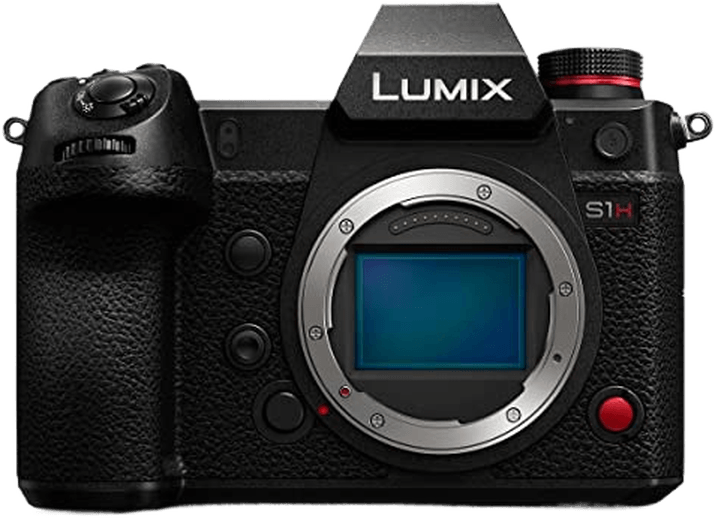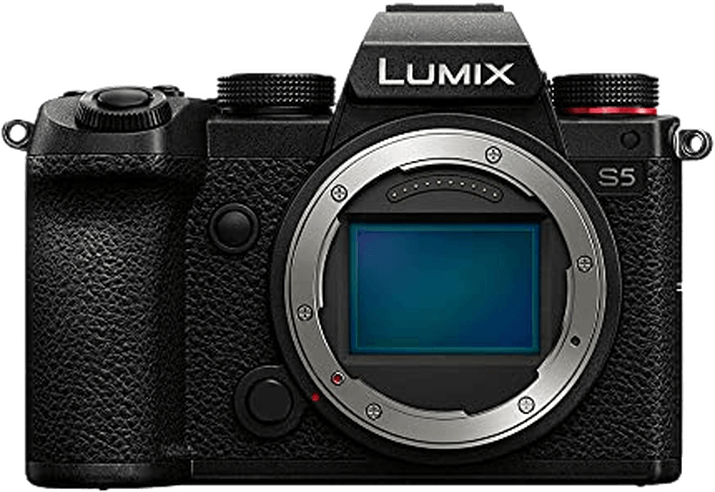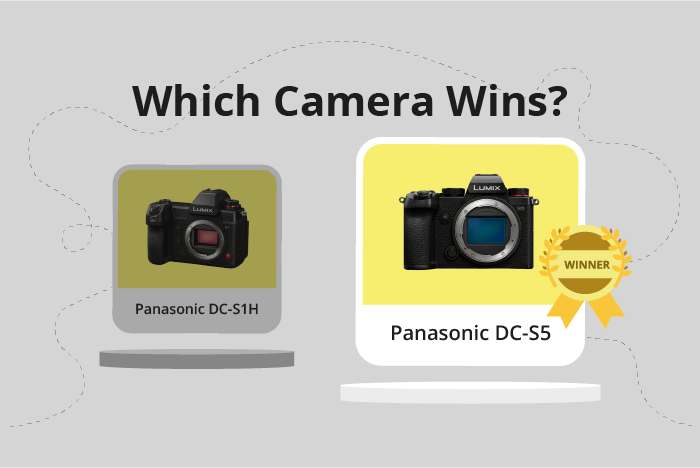Panasonic Lumix DC-S1H vs Lumix DC-S5 Comparison
Panasonic Lumix DC-S1H

Panasonic Lumix DC-S5

The Panasonic Lumix DC-S5 comes out ahead with a score of 79/100, while the Panasonic Lumix DC-S1H trails slightly at 77/100. Both cameras share the mirrorless camera type and were released within two years of each other, in 2019 and 2021.
The Lumix DC-S1H excels with its larger body size (151 x 114 x 110mm) and heavier weight (1052g / 2.32lbs), which can provide better stability for professional use. However, it comes with a higher launch price of $3999.
On the other hand, the Lumix DC-S5 has a more compact design (133 x 97 x 82mm) and lighter weight (714g / 1.57lbs), making it easier to carry and handle. Additionally, it has a lower launch price of $1999, making it more accessible for a wider range of users.
Taking these factors into account, the Lumix DC-S5 offers a better balance of performance, portability, and affordability, while the Lumix DC-S1H caters more towards professional users with its larger size and higher price point.
Panasonic Lumix DC-S1H vs Lumix DC-S5 Overview and Optics
The Panasonic Lumix DC-S5 outperforms the Lumix DC-S1H in optics, scoring 78/100 compared to the S1H’s 74/100. Both cameras share several key specifications, including a 24-megapixel CMOS sensor, the Venus Engine processor, a full-frame sensor size, Leica L lens mount, and image stabilization.
The Lumix DC-S5 gains an advantage with its slightly higher 24.2-megapixel count, providing marginally better image resolution. Additionally, the S5’s DXOMARK score for the sensor is significantly higher at 94, compared to the S1H’s 75, indicating that the S5 produces superior image quality and low-light performance.
However, the Lumix DC-S1H does have a faster shooting speed of 9 frames per second, compared to the S5’s 7 frames per second. This makes the S1H more suitable for capturing fast-moving subjects or action photography.
Taking these factors into consideration, the Panasonic Lumix DC-S5 is the better option for those seeking higher image quality and better low-light performance. The Lumix DC-S1H, while falling short in these areas, still excels in fast-action shooting situations. Ultimately, the choice between these two cameras comes down to the specific needs and preferences of the photographer.
Panasonic Lumix DC-S1H vs Lumix DC-S5 Video Performance
The Panasonic Lumix DC-S1H emerges as the winner in the video capabilities comparison, with a score of 96/100, while the Panasonic Lumix DC-S5 scores 83/100. Both cameras share some video specifications, such as time-lapse functionality built in, which is useful for creating stunning time-lapse videos.
The Lumix DC-S1H outperforms the DC-S5 in several aspects. First, it boasts a maximum video resolution of 6K, compared to the 4K resolution of the Lumix DC-S5. This allows the DC-S1H to capture more detailed and higher quality video footage. The DC-S1H also has larger maximum video dimensions of 5952 x 3988, while the DC-S5 has dimensions of 3840 x 2160, which further contributes to the superior video quality of the DC-S1H. Additionally, the DC-S1H offers a maximum video frame rate of 120fps, which is double the 60fps offered by the DC-S5. This higher frame rate enables smoother slow-motion video capture on the DC-S1H.
The Lumix DC-S5, despite scoring lower, still has impressive video capabilities. It offers 4K resolution and a maximum video frame rate of 60fps, which is adequate for most users and video applications. While it may not be as advanced as the DC-S1H, it remains a reliable option for videographers.
Comparing the video capabilities of the Panasonic Lumix DC-S1H and the Panasonic Lumix DC-S5, it is evident that the DC-S1H is the superior camera in terms of video performance. The higher resolution, larger dimensions, and faster frame rate make it a better choice for videographers seeking top-notch video quality. However, the DC-S5 remains a strong contender with its 4K resolution and 60fps frame rate, suitable for most users and applications.
Panasonic Lumix DC-S1H vs Lumix DC-S5 Features and Benefits
The Panasonic Lumix DC-S1H emerges as the winner in the features category with a score of 87/100, while the Panasonic Lumix DC-S5 trails closely with a score of 85/100. Both cameras share several common specifications, such as touchscreen capabilities, flip screens, WIFI, Bluetooth, and the absence of GPS.
The S1H outperforms the S5 in screen size and resolution. The S1H has a 3.2-inch screen, whereas the S5 has a smaller 3-inch screen. Furthermore, the S1H boasts a higher screen resolution of 2,330,000 dots, compared to the S5’s 1,840,000 dots. This means that the S1H provides a larger and clearer display for users, which can be especially beneficial for framing shots and reviewing images.
On the other hand, the S5 has its advantages despite the lower feature score. The S5 is known for its compact and lightweight design, making it more portable and convenient for on-the-go photographers. While not directly related to the features discussed, this aspect should not be overlooked when comparing the two cameras.
Taking all of these factors into account, the Panasonic Lumix DC-S1H’s larger and higher-resolution screen gives it an edge over the DC-S5 in terms of features. However, potential buyers should also consider factors such as size and weight when making their decision, as the DC-S5’s portability may be an important consideration for some users. Ultimately, both cameras offer impressive features, but the S1H slightly outshines the S5 in this particular category.
Panasonic Lumix DC-S1H vs Lumix DC-S5 Storage and Battery
The Panasonic Lumix DC-S1H and the Panasonic Lumix DC-S5 both score 71/100 in storage and battery, showing no overall winner in this category. Both cameras have two memory card slots and accept SD/SDHC/SDXC (UHS-II compatible) memory cards. They also support USB charging.
The S1H has a battery life of 400 shots using the DMW-BLJ31 battery, while the S5 edges slightly ahead with a battery life of 440 shots using the DMW-BLK22 battery. This difference in battery life makes the S5 slightly better in terms of power consumption and shooting time.
However, both cameras perform equally well in terms of storage options and charging capabilities. Therefore, the choice between the S1H and S5 in terms of storage and battery will depend on individual preferences and requirements, with the S5 offering a slightly longer battery life.
Alternatives to the Panasonic Lumix DC-S1H and Lumix DC-S5
Are you still undecided about which camera is right for you? Have a look at these popular comparisons that feature the Panasonic Lumix DC-S1H or the Panasonic Lumix DC-S5:

